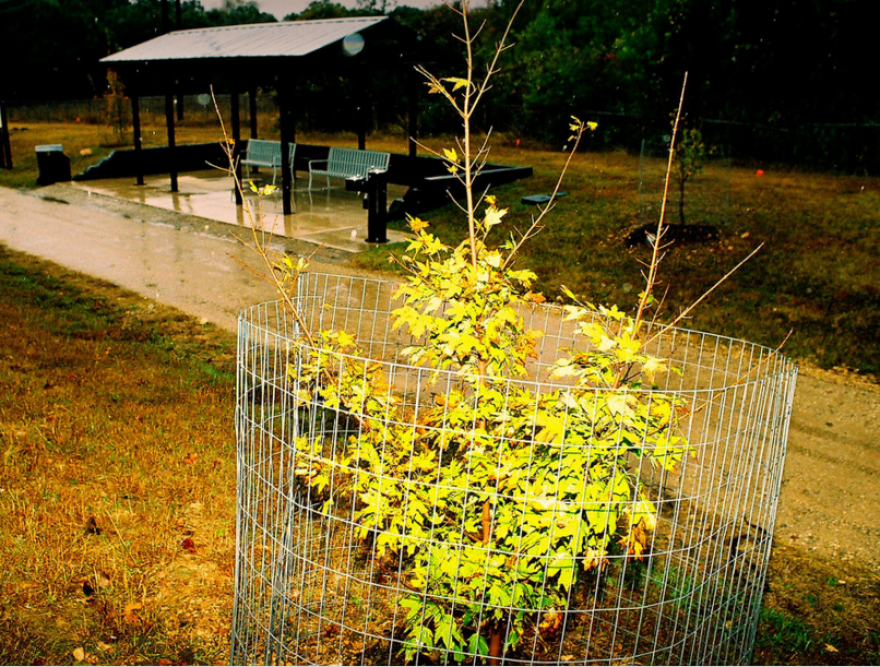
Suzanne Young, program manager for Bigtooth Maples for Boerne, was out on a recent weekend with the Native Plant Society giving away 141 maple trees.
“Hi Bill, did you get your care instructions?” she asks of Bill Beall, who--like all those getting the trees--is a local.
“This is ‘To Kill a Maple Tree.’ It’s confessions from tree owners—how they killed their maple tree,” Young says. “This is true for just about any native tree in Texas. So, I think it’s real important that you …”
Beall, smiling, interrupts, “I’m not going to kill mine. I promise.”
Young laughs. “Alright,” she says. “You heard it here. All these witnesses.”
Everyone taking home a tree had to go through an application process to get one. That’s because the Bigtooth Maples have been in trouble and the plant society is hoping efforts like this will help bring them back.
“This whole area would have been covered in Bigtooth Maples after the ice age some 10,000 years ago,” she says. “Slowly, with climate change, and with deer overpopulation, they’re scattered through the western United States, but only in pockets, mostly in canyons. Places where they’re protected. They’re considered lost because you might not find another pocket of them for a hundred miles.”
Aside from Lost Maples State Park, you can’t really find Bigtooth Maples in most parts of Texas, aside from Tapatio Springs and Boerne, their eastern most habitat. That scarcity is not ok with Mary Morton.
“Trees are special. Trees are our lifeline…. I’m not sure what to say,” Morton says.
But she knows what to do. Morton’s taken home at least one tree every year since the program began a decade ago.
“Many are planted by San Antonio Street by the creek so eventually everybody will be able to see them,” she says.
One of the application requirements is to promise to plant your tree where it is visible to the public either by the street or on a public trail.

Young says, “The colors range from golden color to an orange to a beautiful red. They provide spectacular color in the fall here. We hope to make Boerne a fall foliage destination. My favorite time of year is when they just begin to turn. It’s almost like they’re blushing. That to me is the beginning of fall in Texas.”
But they still have a ways to go for that to happen because of the deer.
“We suspect that’s why we don’t have as many as we should,” Young says. “Find pockets in canyons where deer can’t get to them. Deer eat smaller trees. We’re missing the seedlings and adolescents. We have the old growth.”

So, the Native Plant Society provides wire mesh cages.

Participants must keep their maple in the cage for 10 years until it’s mature and tall enough to be out of harm’s way from the deer.
“Without the leaves on the tree, the tree can’t survive,” Young says.
Beall, who promised not to kill his Bigtooth Maple, has loaded his truck with his cage, mulch and stakes. Next step is to pick out his tree.
“Which two trees would you like?” Young says.
Beall replies, “I’ll just take the closest one.”
“Whatever makes you happy sir,” Young says.
Beall lifts the tree and groans.
The tree is not much to look at—yet. It’s small and spindly and its leaves are dry and brown. But Young says that’s the strategy. If you plant young trees when they’re dormant, it gives them a chance to establish a deeper root system before summer gets here.

Beall loads his maple into his truck and drives away.
“You guys take care,” he says.
“Good luck. Alright. We’ll be watching,” Young replies.
As for Morton? Hopefully, she’ll have some room left by her creek. After participating in the program from its beginning, she’s bringing home her 13th and 14th Bigtooth Maple trees today.







